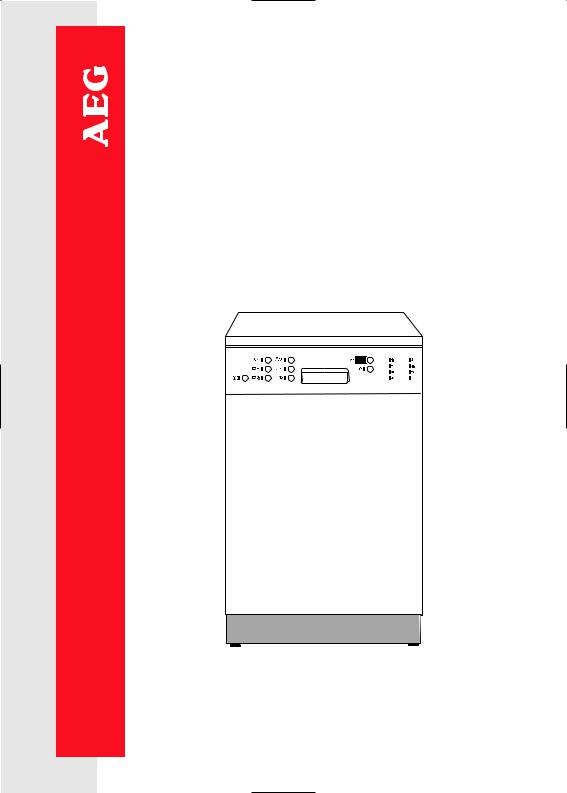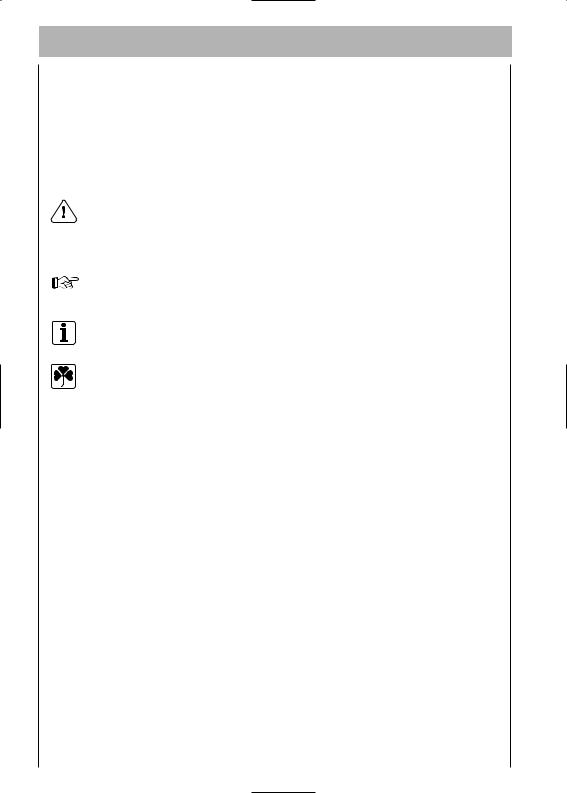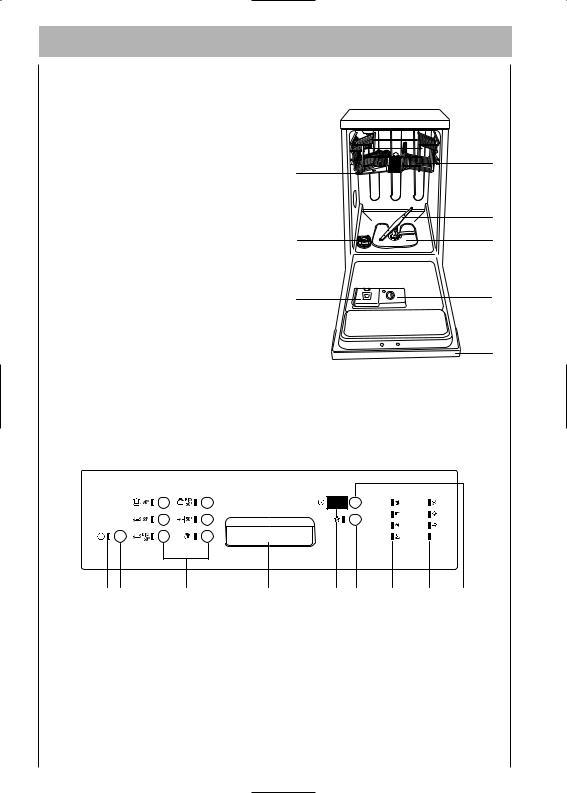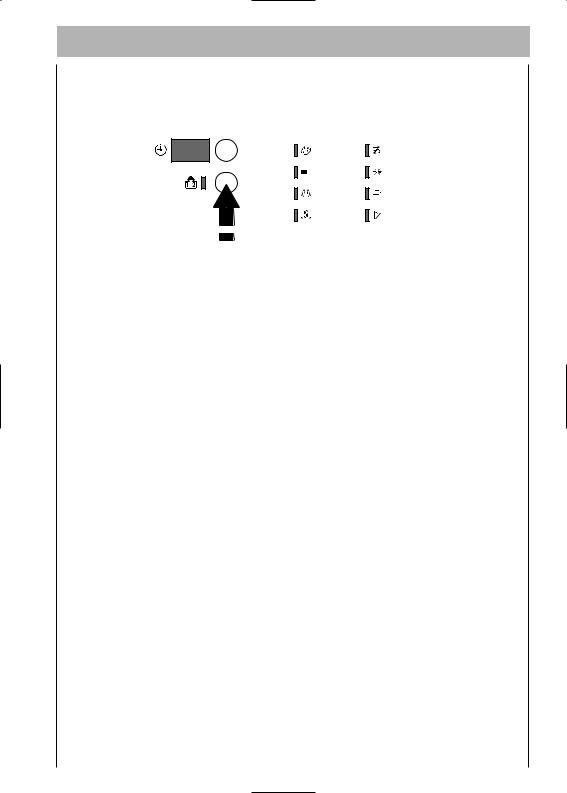AEG-Electrolux F64800W User Manual

ÖKO_FAVORIT 64800
Dishwasher
Lavavajillas
Operating instructions Instrucciones de uso

Dear customer!
Please read these user instructions carefully.
Above all please observe the safety instructions on the first few pages of these user instructions! Please keep these user instructions for later reference. Pass them on to any subsequent owner of the appliance.
The warning triangle and/or specific words (Warning!, caution!, Important!) are used to highlight instructions that are important for your safety or for the function of the appliance. It is imperative that these instructions are observed.
This symbol or numbered instruction steps lead you step by step through the operation of the appliance.
Next to this symbol you receive additional information and practical tips on using the appliance.
Tips and instructions for the economical and environmentally conscious use of the appliance are marked with a clover leaf.
In the event of a malfunction, these operating instructions contain information on how to rectify faults yourself, see "What to do, if..." section.
If these instructions are insufficient, please contact your nearest customer service centre.
In the case of technical problems, our customer service organisation is available to provide you with assistance at any time (you will find addresses and telephone numbers in the "Customer Service Centres" section).
Printed on paper manufactured with environmentally sound processes.
He who thinks ecologically acts accordingly...
2

Contents
Safety instructions |
4 |
|
|
Disposing of packaging and old machine |
6 |
|
|
Disposing of the packaging |
6 |
|
|
Disposing of your old machine |
6 |
|
|
Economical and ecological dishwashing |
7 |
|
|
Description of the appliance |
8 |
|
|
The inside of the appliance |
8 |
|
|
Control panel |
8 |
|
|
Before using your dishwasher for the first time |
12 |
|
|
Setting the water hardness range |
12 |
|
|
Filling with special salt |
14 |
|
|
The rinse aid |
15 |
|
|
Loading cutlery and dishes |
17 |
|
|
The lower basket |
18 |
|
|
Cutlery basket |
19 |
|
|
The upper basket |
20 |
|
|
Adjustment the height of the upper basket |
21 |
|
|
Use of detergent |
22 |
|
|
Bio programmes and compact powders |
23 |
|
|
Washing programmes |
24 |
|
|
Operating instructions |
26 |
|
|
Maintenance and cleaning |
31 |
|
|
Internal and external cleaning |
31 |
|
|
Cleaning the filters |
31 |
|
|
What do do, when... |
33 |
|
|
Customer service |
35 |
|
|
Hints for test centres |
36 |
|
|
Technical data |
37 |
|
|
Installation and connection instructions |
38 |
|
|
Adjusting the worktop |
38 |
|
|
Fitting under a counter |
38 |
|
|
Levelling |
38 |
|
|
Connecting the water supply |
39 |
|
|
Water outlet connection |
40 |
|
|
Water protection system |
42 |
|
|
Electrical connection |
42 |
|
3 |
|

 Safety instructions
Safety instructions
The safety of AEG electrical appliances conforms to accepted rules of technology and the Appliance Safety Act. We as manufacturers, however, see ourselves as being obliged to familiarise you with the following safety instructions.
Using your dishwasher for its intended purpose
●Only use your dishwasher for machine washing of household crockery. If your machine is misused or used for any purposes other than that
for which it is intended, the manufacturer cannot be held liable for any damage caused.
●For safety reasons, you should not convert or modify your dishwasher in any way.
Before using your dishwasher for the first time
●Check your dishwasher for any transport damage. Never connect a damaged machine. If your dishwasher is damaged, you should contact your supplier.
●Your dishwasher must be correctly installed and connected. Please read the section on "Installation" to make sure you know all about this.
●Before using your dishwasher for the first time, do not forget that the nominal voltage and current type indicated on the rating plate of your machine must be the same as the nominal voltage and current type at the installation site. The necessary electrical fusing is also given on the rating plate.
Child safety
●Packaging parts (e.g. foils, styrene foam) may be dangerous for children,who could even be suffocated! You should therefore keep all packaging well away from children.
●Children may not recognise the dangers of improper use of electrical appliances. You should therefore ensure proper supervision during operation and not allow your children to play with your dishwasher.
●Detergents may have a caustic effect on eyes, mouth and throat and may even cause suffocation! Keep all detergents in a safe place out of children’s reach.
4

●The water in your dishwasher should not be used for drinking. Detergent residues may still be present in your machine. Make sure you do not splash these caustic residues onto your skin or suffocate yourself! Keep children well away from your dishwasher when its door is open.
Your dishwasher in day-to-day use
●Never operate your dishwasher if the electrical supply lead, supply or drainhose, control panel, worktop or plinth are damaged.
●If there is a fault, first turn the water tap off. Then switch off your machine and pull the plug out of the socket. If there is a fixed connection, switch off or unscrew the fuse(s).
●Never pull the plug out of the socket by the cable - always hold the plug.
●Dishwasher repairs should only be performed by trained personnel. Improper repairs may seriously endanger the user. If your dishwasher needs to be repaired, you should contact our service centre or your retailer.
●Never place any solvents in your dishwasher or you may cause an explosion!
●Do not rest or sit on the open door or the machine could tilt.
●Before using special dishwasher salt, detergent or rinse-aid, make sure that the manufacturer of these products expressly specifies their use in domestic dishwashers.
●Always turn off the water tap when your dishwasher is left unattended for any length of time, e.g. when you are away on holiday.
●Only transport the dishwasher in an upright position. Tipping it upside down during transport could cause salty water to leak into the internal compartment and lead to the formation of rust.
5

Disposing of packaging and old machine
Disposing of the packaging
Our dishwashers require effective protective packaging in transit, though we always confine ourselves to what is absolutely necessary.
Warning! Packaging parts (e.g. foils, styrene foam) may be dangerous for children, who could even be suffocated! You should therefore keep all packaging well away from children.
All packaging materials used are environmentally compatible and reusable.
The cardboard parts are produced from recycled paper, and the wood is untreated.
The plastics are marked as follows:
>PE< |
for polyethylene, e.g. packaging foils. |
>PS< |
for polystyrene, e.g. padding (essentially CFC-Free). |
>POM< |
for polyoxymethylene, e.g. plastic clamps. |
Give the packaging for reuse to your local recycling centre. Your municipal or local authority will give you its address.
Disposing of your old machine
When your machine finally reaches the end of its life and you withdraw it from service, you should render it unserviceable before having it disposed of.
Warning! Children at play could lock themselves in your machine (and suffocate) or otherwise endanger their lives. Therefore pull out the main plug and detach and discard the electrical supply lead.
Disable the door lock so that the door no longer closes.
Marking of plastic parts for graded recycling: all plastic parts in your machine are marked with internationally standardised abbreviations (e.g. <PS> for polystyrene). When your machine is disposed of, this enables plastic waste to be sorted into individual types for environmentally conscious recycling.
Take your decommissioned machine to your local recycling centre or dealer, who will take it back from you for a small handling charge.
6

 Economical and ecological dishwashing
Economical and ecological dishwashing
●Only connect the dishwasher to the hot water supply if your hot water is not electrically heated.
●Ensure that the water softener is correctly adjusted.
●Do not pre-rinse under running water.
●Select the wash programme to suit the nature and degree of the soiling on the dishes.
●Do not use more detergent, special salt or rinse aid than is recommended in these operating instructions and by the manufacturer of the respective product.
7

Description of the appliance
The inside of the appliance
1. |
Upper spray arm |
|
|
2. |
Salt container |
|
|
3. |
Detergent dispenser |
1 |
|
4. |
Control panel |
||
|
|||
5. |
Rinse aid dispenser |
|
|
6. |
Filters |
2 |
|
7. |
Lower spray arm |
|
|
8. |
Upper basket |
3 |
|
|
|
IN95
Control panel
1 2 |
3 |
4 |
5 |
6 |
7 |
8 |
9 |
1.On/Off indicator light
2.On/off pushbutton
3.Programme selection pushbuttons
8
8
7
6
5
4

|
|
|
|
|
4. |
Door handle |
|
|
|
||
|
5. |
Digital display |
|
|
6. |
"Small load" pushbutton |
|
|
|
This is very useful and economical when only a few dishes need |
|
|
|
washing. |
|
|
|
Remember to load the crockery into both baskets. The indicator light |
|
|
|
corresponding to this option will come on when selected. |
|
|
7. |
Programme phase indicator lights |
|
|
|
As soon as you select a washing programme, this illuminates all the |
|
|
|
phases the programme consists of. |
|
|
|
As the programme progresses, the phase under way will illuminate. At |
|
|
|
the end of the programme the phase indicator lights turn off. |
|
|
|
Each phase is indicated with a symbol |
|
|
|
Prewash/Rinse and Hold |
|
|
|
Wash |
|
|
|
Rinse |
|
|
|
Drying |
|
|
8. |
Indicator lights |
|
|
|
Salt |
|
|
|
Illuminates when the salt has run out, to remind you to refill the |
|
|
|
salt container. |
|
|
|
Rinse aid |
|
|
|
Illuminates when the rinse aid has run out, to remind you to refill |
|
|
|
the rinse aid dispenser. |
9 |

Water tap
Flashes when:
-The water tap is closed.
-The mains supply has been cut off.
-The inlet hose may be blocked.
Open door
Flashes when the door has not been properly closed.
9. "Delay start" pushbutton
Allows the start of the programme to be delayed by a minimum of 1 hour, up to 12 hours.
Audible signals have been introduced to help indicate which operations the dishwasher is performing.
"Instruction accepted" audible signal
When any of the pushbuttons are pressed, an audible signal informs you that the machine has accepted the instruction given.
"Programme run" audible signal
An audible signal informs you that the washing programme is starting.
"End of programme" audible signal
An intermittent audible signal informs you that the wash programme has ended.
"Alarm" audible signal
The machine is fitted with a number of alarm systems to help you determine the cause of any problems (see "What to do, if...").
An audible signal informs you that an alarm is activated.
10

To deactivate these audible signals, press the "small load" pushbutton for about 3 seconds, at the end of which an audible signal informs you that the audible signals have been deactivated.
SO280
To reactivate these audible signals, press the "small load" pushbutton for about 3 seconds, at the end of which an audible signal informs you that the audible signals have been reactivated.
Both operations (to deactivate or reactivate the audible signals) must be carried out before starting a washing programme; the setting will remain memorised after switching off the dishwasher.
11

Before using your dishwasher for the first time
1.Ensure that the electrical and water connections comply with the installation instructions.
2.Remove all packaging from inside the appliance.
3.Set the water softener.
4.Pour 0,5 l of water inside the salt container and then fill with salt.
5.Fill the rinse-aid dispenser.
Setting the water hardness range
The dishwasher is equipped with a water softener designed to remove minerals and salts from the water supply, which would have a detrimental or adverse effect on the operation of the appliance.
The higher the content of these salts, the harder your water is.
Water hardness is measured in equivalent scales, German, French degrees and PPM (parts per Million).
The softener should be adjusted according to the hardness of the water in your area. Your local Water Authority can advise you on the hardness of the water in your area.
The dishwasher is factory set at level 4.
If this level is not suitable for your area the softener should be adjusted.
Level |
|
|
|
Water hardness |
|
Use of salt |
|||
|
|
|
|
|
|
|
|||
°dH |
°TH |
PPM |
|||||||
|
|
(german degrees) |
|
(french degrees) |
|
(parts per million) |
|
|
|
|
|
|
|
|
|
|
|
|
|
0 |
|
0 - 4 |
0 - 8 |
0 - 80 |
|
NO |
|||
1 |
|
5 |
- 8 |
9 - 14 |
81 - 140 |
|
YES |
||
2 |
|
9 - 11 |
15 - 20 |
141 - 200 |
|
YES |
|||
3 |
|
12 |
- 17 |
21 - 30 |
201 - 300 |
|
YES |
||
4 |
|
18 |
- 22 |
31 - 40 |
301 - 400 |
|
YES |
||
5 |
|
23 |
- 28 |
41 - 50 |
401 - 500 |
|
YES |
||
6 |
|
29 |
- 33 |
51 - 60 |
501 - 600 |
|
YES |
||
7 |
|
34 |
- 39 |
61 - 70 |
601 - 700 |
|
YES |
||
8 |
|
40 |
- 45 |
71 - 80 |
701 - 800 |
|
YES |
||
9 |
|
46 |
- 50 |
81 - 90 |
801 - 900 |
|
YES |
||
12

If your water hardness is level 0 it is already soft and therefore there is no need to use salt. With the setting of the water softener at level 0 the salt indicator light on the control panel will always remain off.
To set a different level, proceed as follows:
1.Press the On/Off pushbutton.
2.Press the "small load" and "delay start" pushbuttons simultaneously for about 5 seconds, in the display will appear L4 which corresponds to the current level.
2.Press the "delay start" pushbutton as many times as necessary until the required level appears in the display. The level increases by 1 each time the pushbutton is pressed. 5 seconds after this pushbutton has last been pressed the dishwasher memorises the level selected and returns to the programme setting mode.
SO281
13
